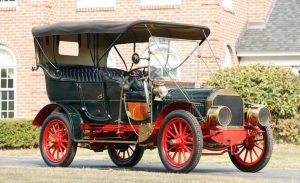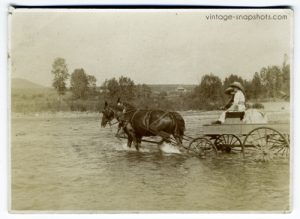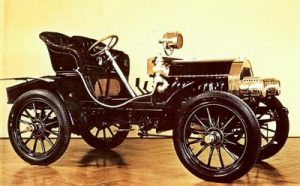by Templa Melnick | Jul 22, 2014 | Colorado history
On family road trips as a child, my mind would be a hundred years away as I contemplated what it was like to be rattling over the sagebrush in a covered wagon. Once, in a rare moment with my grandmother, she told me that she rode from Missouri to South Dakota in a covered wagon when she was a little girl. My awe amused her. She quickly dashed my romanticized (thanks Hollywood!) image of the event to the rocky ground. Her version included biting flies the likes of which I’ve only seen in horror movies, miserable heat and humidity, and endless hours of unchanging scenery broken up by harrowing river crossings and broken wagon wheels. She remembered the broken wheels vividly because her father expanded her vocabulary during a repair.
Today, as I drive along the (mostly) modern highways of western Colorado, with my air conditioner and i-tunes blasting, I can’t help but think of the hearty folks who clambered over these roads before they were paved. What was it like to trek from Grand Junction to Montrose a hundred years ago? How long did it take to schlep over the magnificent Rocky Mountains that divide the state of Colorado into the eastern and western slopes? Who drove the first cars in this lovely state?
In my book, Season of Forgiveness, I staged a silly – and slightly unnecessary – scene with a race between a motor car and a team of horses pulling a wagon. I chose the Pierce-Arrow motor car for my fictional race for two reasons. First, it was the largest car manufactured at the time, and Emma has a large family. Secondly, the Pierce-Arrow was the most luxurious and expensive automobile manufactured at that time and for many years afterwards.

As the Civil War tore our nation apart, George Pierce began his career by manufacturing ice-boxes, birdcages, and bathtubs. He later built bicycles, which were the hot item of the 1890’s, before becoming an automaker. He built his first Pierce Motorette in 1901 with a single cylinder, 31/2-horsepower, water-cooled deDion engine in the rear, replaced in 1903 by Pierce’s own engine. Some 170 Motorettes were made between 1901 and 1903. Next, there was the Stanhope with its Pierce engine under the driver’s seat.
In 1904, the Great Arrow appeared with a four-cylinder Pierce engine. It used cast aluminum body panels, one of many Pierce-Arrow innovations. Pierce- Arrow used aluminum extensively during its history. The 1904 Great Arrow cost $4,000, making it one of the most expensive cars at the time.
Even with such innovations as the Pierce-Arrow’s cast aluminum body panels and four-cylinder engine, early automobiles struggled with Colorado’s rough mountain terrain and the distances between communities. Fuel for the engines was not always readily available.
It would be another fifteen years or so before automobiles were common place in western Colorado. According to a few of the local old-timers, many western slope ranchers and farmers still preferred their trusty team of horses and wagon well into the 1930’s.
According to the history buffs at the Pierce-Arrow Society, (Pierce-Arrow.org)

Trusty Team and Wagon
Pierce-Arrows were bought by the rich and famous worldwide. The long and impressive list of owners included heads of state, royalty, congressmen, ambassadors, governors, businessmen, entertainers, and as in MY story, lucky gamblers. Pierce-Arrows were part of the White House fleet from the Taft to Roosevelt administration. In 1909, President Taft, the first President to use an automobile for official duties, ordered two Pierce-Arrows, a brougham and a landaulette. The last Presidential Pierce-Arrow was a 1935 model.
Just in case you were wondering, the car in the photo, a 1905 Pierce-Arrow, was sold at auction a few years back for over $200,000. Sadly, the innovative manufacturer that brought this beauty into the world was hit very hard during the Great Depression and is no longer in existence
As I maneuver the well-traveled interstate today, I’ll try not to grumble at the construction delays or the other drivers who are distracted by their cell phones and toddlers in the backseats. Instead, I’ll let my mind wander as I settle into my climate controlled leather seat. I’ll imagine what this drive would have been like in 1904. Would I have been one of the brave and prosperous few to attempt this drive in a Pierce-Arrow? Or would I drive the tried-and-true team of horses and wagon? I’ll imagine the tedium interspersed with danger of the trek across these beautiful mountains that I am blessed to call my home. Sometimes an overactive imagination comes in handy.

1904 Pierce-Arrow

by Templa Melnick | Jul 15, 2014 | Templa's Trivia

Good things come in 3’s
Good Things Come in 3’s!
No one ever really thinks that life imitates art… until it happens to them.
I created a character in my novel, Emma, who is the mother of seven sons. The inspiration for Emma came from my own lineage of amazing, strong, determined women. My grandmothers – and my husband’s grandmothers – were women who crossed the prairies in covered wagons, raised children in challenging circumstances, endured hardships I can’t even imagine, and still managed to maintain a sense of humor and a love of life in general. Yeah. They’re a pretty amazing group of women.
But let’s go back to “mother of seven sons.” In the story, Emma and her husband Jake have two sets of twin boys. When I wrote the book, there were no twins in our family. The idea of twins was fun to think about, but I didn’t have any first – hand knowledge of what it would be like to give birth to or raise twin boys.
As my book hits the streets – or stands, or whatever books hit when they’re published, my daughter-in-law is pregnant with our first grandbabies. Yes, that is plural. Twins. Twin boys. They’ll arrive sometime this fall. (Shhh…. don’t tell L that Emma had seven sons. That’s as cruel as the husband who starts talking about baby number two when his wife is in the recovery room with their first child after 20million hours of labor.) But not to worry. She’s not the only daughter-in-law.
Because awesome things happen in threes, my OTHER daughter-in-law will be bringing the first ever Melnick girl into the world sometime around Thanksgiving. I’ve seen my tiny granddaughter in a fuzzy, blurry ultrasound. She waved at me. Really. She did. I could at least recognize the little hand as a hand. The rest of it, I had to take on faith that the ultrasound tech knew her stuff.

Baby girl bun in the oven

Twin boy buns in the oven
The notion of twins has now transformed from the highly romanticized version in my head to the reality of two of everything. That means L is making room as best she can for two growing babies in her not-so-long-ago itty bitty body. And she’s learning on the fly about the dozens of medical terms and complications that come along with the double blessing of twins. My son and his wife are making huge adjustments in their lives to make room for these two wonderful baby boys. And their two cribs, two car seats, two high chairs. Well, you get the idea.
So of course, I can’t help but ponder what it was like for Emma when she was pregnant with her twins, back in 1884. Was she aware she was having twins? Probably not. Ultrasound technology was a long way off. Did she have to scramble after the babies’ births to find another cradle, another everything? Probably! Did she have help with the two newborn babies? Again, probably not. And she didn’t have a phone, google, or a community of mommy-bloggers to go to for advice. No wonder she’s so unflappable now.
So often, we tend to romanticize past eras. Maybe that’s just me. I envisioned a life of riding horses across an open field instead of racing around in rush hour traffic. I imagined peacefully hanging clothes on a clothesline while the sheets snapped in the breeze instead of waiting for the appliance repairman to show up. I dreamed of the joyous freedom that would come from a self-sustaining lifestyle while compiling a sales presentation at midnight amidst stacks of unopened bills. The reality is that our modern life is complicated. But with our complications, some tremendous improvements have also come about.
According to the Center for Disease Control, at the beginning of the 20th century, for every 1000 live births, six to nine women in the United States died of pregnancy-related complications, and in some U.S. cities, up to 30% of infants died before reaching their first birthday. (CDC MMWR Weekly, October 01, 1999 / 48(38);849-858)
With that being said, I’m very, very happy that MY grandchildren will be born in this time and place, to mommies with excellent nutrition and access to good medical care. My grandbabies have mommies and daddies who are making sure that they’ll have all the stuff on hand that these little ones will need. And, possibly a lot of stuff they won’t need. (Don’t judge. There are some irresistible baby things out there! And grandmothers get excited.)
Don’t forget the amazing technology at new parents’ fingertips. Colic? Teething? All of those “is this normal?” questions that usually come up in the wee hours of the night. With just a tap or two on your smart-phone, you can find suggestions, advice, and pages and pages of whining mothers who blog about stuff that makes you feel like a superstar for coping without drama.
So, I’m feeling a lot of sympathy for Emma. Sorry I made your life so challenging, girl. But I’m also thinking that right now is a good era. I’m looking forward to the adventures with my grandchildren that will take place in the not-so-distant-future.


by Templa Melnick | Jun 16, 2014 | Templa's Trivia

As my husband and I chatted over his Father’s Day breakfast, he shared happy childhood memories of long-ago breakfasts with his grandmothers and of the meals of wild game and home grown vegetables his grandfather had provided.
Food – and the preparation of food, is an integral part of our lives, our memories, and the heritage we pass to the next generation. Influenced not only by taste and cultural preferences, but by availability and (increasingly) sensitivities to certain foods, we each develop unique, personal favorites that will last throughout our lifetimes.
Some of the foods Emma and the gang eat in Season of Forgiveness are based on my own family’s recipes passed from one generation to the next. And some, such as the Trout Almandine, are items that would have been served in that particular time and place. In my search for authentic foods and recipes that my characters could and would eat and enjoy, I read through a lot of recipe books. The amount of butter and cream used in the Victorian era was astounding – and gave my modern day stomach a grumbly twinge just thinking about it.
I was baffled by so many old recipes that included paraffin as an ingredient. I mean, this is the stuff you melt down and pour over the top of the jelly jars to seal them, right? It’s wax. It’s made from petroleum. I freely admit that I’m no foodie. I can cook. And I have a few family favorites to my credit. But I’m far from a gourmet chef. So I had to check this out. And what I discovered really surprised me.
 Paraffin was used in baking during World War II when rationing and scarcity made butter and shortening hard to come by. Resourceful cooks used it to stretch ingredients a little further in many recipes. Here’s a Paraffin Sponge Cake Recipe that I stumbled across.
Paraffin was used in baking during World War II when rationing and scarcity made butter and shortening hard to come by. Resourceful cooks used it to stretch ingredients a little further in many recipes. Here’s a Paraffin Sponge Cake Recipe that I stumbled across.
www.bbc.co.uk/history/ww2peopleswar/stories/85/a5416085.shtml
And, check out my website for a few recipes I found in an old Methodist church ladies cookbook. (These are tasty treats by Midwestern US ladies with names like Leona and Ethyl and Edith.) www.templamelnick.com
Paraffin is added – even today – to many candies, and especially chocolates. The paraffin gives the candy a smooth, shiny finish and prevents it from melting. It also inhibits bacterial growth. Well, that sounds okay. It’s also added to a variety of other processed foods. So, whether I realize it or not, I’m probably ingesting paraffin. Is that bad?
Actually… it could be bad. If you scarf down the aforementioned Paraffin Sponge Cake, you may want to make sure you’ve got immediate access to good plumbing. Seriously. Paraffin is used to treat colicky horses and cattle, and is the main ingredient in some over the counter laxatives for humans. But, more long term effects could be potentially serious. According to a study that appeared in the Journal of Applied Toxicology, parabens are fat loving chemicals that build up in our fat cells and were found in significant numbers of breast cancer tumors. (Darbre, P. D., Aljarra, A., Miller, W. R., Coldham, N. G., Sauer, M. J., Pope, G. S. Concentrations of Parabens in Human Breast Tumours. Journal of Applied Toxicology 24(1): 5-13.) Parabens -such as those found in paraffin – are chemicals that effect the body’s ability to assimilate estrogen-related chemicals, potentially leading to an imbalance of estrogen and other hormones. Additionally, the lotions, shampoos, conditioners and cosmetics we use are loaded with parabens- thus creating an even greater possibility of harmful effects.
So, why and I telling you any of this? Simply, this: If you’re determined to replicate Great Aunt Martha’s Candy Balls…go ahead. Enjoy. I’ll even give you the recipe. (Check my website!) But if you skip the paraffin and your homemade candy balls melt all over your grandkids chins … that’s probably even better. After all, I want you to make as many memories as possible with your loved ones. Because the way I see it, that’s what food is all about. Oh, and one more thing… From now on, splurge on the good chocolate… the stuff without added wax and fillers. You’re SO totally worth it.

by Templa Melnick | Jun 3, 2014 | Colorado history

I’m a history geek. I admit it. I just can’t seem to help myself. So when my husband and I stumbled upon a museum that had recreated an entire town, we couldn’t resist. Actually, I couldn’t resist – and my husband is a really patient man.
Museum of the Mountain West, outside of Montrose, Colorado is definitely a perfect place for geeks like me. And the proprietor was more than happy on that blustery, snowy day to give us a guided tour. (Yes, possibly because we were the only ones crazy enough to be out in a snowstorm. We had the place to ourselves.)
Click here to visit their website. www.mountainwestmuseum.com

Museum of the Mountain West, Montrose, CO
While I was wandering through one of the immaculately restored buildings, I stumbled upon a collection of tin cans that once held various types of food. One of the most popular? Canned mutton. Just the sound of it made me shiver. Eeew.
But, my modern prejudices aside, it was an extremely popular item with many miners, homesteaders and other early residents of western Colorado. Canned mutton was inexpensive, traveled well, could be heated over a camp fire, and provided much needed protein. But… even with all of those virtues, it was an acquired taste with a very strong odor, and a taste to match.
Thanks to Charles, Prince of Wales, mutton in making a comeback. He touts it as his favorite dish and has even organized a Mutton Renaissance Campaign to encourage Britons to eat more mutton. As admirable as this is, I’ll bet Prince Charles doesn’t eat his mutton from a can.
Canned mutton actually makes two appearances in my book. Neither of the characters in my book who ate it liked it. But they did eat the stuff. Cold mountain weather and lack of resources will do that to a person. My culinary experiences with mutton are limited to the occasional roasted lamb at Passover. Somehow, I suspect that’s not a fair comparison. Have I ever tried canned sheep meat? Nope. Do I plan on trying it? Nope. I live vicariously through those people I make up in my head. (That’s what fiction writers do. We populate our lives with imaginary people, who do things that we, the writer, may not ever really do.) And they said not to eat the canned mutton.
So, here’s to the stalwart men and women who left behind their empty tin cans and untold stories. They endured harsh Colorado mountain weather, lack of resources, and hardships I can only imagine. I salute you. But the mutton? I’ll leave it for you.
by Templa Melnick | May 19, 2014 | Templa's Trivia
When I was a little girl, we had a full set of embroidered tea towels. This was B.D. (Before Dishwashers.) And we had chores – which included washing the dishes after dinner. Since my sister was four years older and had significantly superior fine motor skills, she washed. I dried. According to my mother’s tea towels, Monday was wash day. They went something like this:
Monday: Wash Day
Tuesday: Ironing Day
Wednesday: Sewing Day
Thursday: Market Day
Friday: Cleaning Day
Saturday: Baking Day
Sunday: Day of Rest
By the time I was drying those Melmac dishes, the way of life embroidered on our tea towels had all but disappeared and those little slips of linen were a last, lingering reminder of days gone by.
But this well known schedule is the way everyone kept house for more than a hundred years.
And, it makes a lot of sense when you think about it. Laundry was the heaviest task a housewife faced, requiring a great deal of strength and determination (also known as grit) to haul the water from the well, build the fire to heat the water, hand-wring clothes and carry big baskets of wet laundry to the clothesline from the washtubs.
Monday was the day to tackle this monumental chore, when you were still fresh and rested from Sunday. Tuesday’s ironing followed Monday’s wash. Mending and sewing on Wednesday made sense when you’d just been through the clothes and noticed what needed a button or a patch.
According to my grandmothers, a good housewife had her laundry on the line shortly after sun rise Monday morning. Unless it was raining. Snow? That didn’t slow them down much. Those clothes just froze right to the line, and there was usually a good, strong wind whipping through at the same time. Brr.
 When did they squeeze in the task of making the lye soap to wash the clothes? Maybe that was a rainy Monday chore.
When did they squeeze in the task of making the lye soap to wash the clothes? Maybe that was a rainy Monday chore.
No wonder they called this the Happy Day washing machine. She had to sit down to agitate those clothes!
As for me, I’m extremely thankful for my aging and slightly shabby Kenmore washer. And I’m also really thankful that I can do my laundry while watching an X-Men marathon. Yep, that’s a definite improvement over “the good ol’ days.” I think I’ll follow my grandmother’s advice, and make a cup of tea and count my blessings. After I fold this load of towels.










 Paraffin was used in baking during World War II when rationing and scarcity made butter and shortening hard to come by. Resourceful cooks used it to stretch ingredients a little further in many recipes. Here’s a Paraffin Sponge Cake Recipe that I stumbled across.
Paraffin was used in baking during World War II when rationing and scarcity made butter and shortening hard to come by. Resourceful cooks used it to stretch ingredients a little further in many recipes. Here’s a Paraffin Sponge Cake Recipe that I stumbled across.



 When did they squeeze in the task of making the lye soap to wash the clothes? Maybe that was a rainy Monday chore.
When did they squeeze in the task of making the lye soap to wash the clothes? Maybe that was a rainy Monday chore.